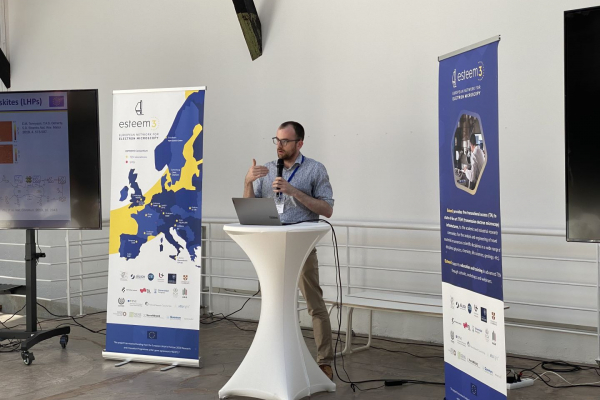TA users presentations during the ESTEEM3 Final event : Sean Collins

During the ESTEEM3 Final Infoday, Dr. S.M. Collins delivered a presentation titled "Hybrid composites for bright and stable light emission," which explored the development of hybrid composites for achieving enhanced and stable light emission. His research focused on addressing various challenges associated with the use of these composites in Light-Harvesting Perovskites (LHPs).
One of the key challenges highlighted by Dr. Collins was the temperature-dependent crystal structures of LHPs. As these materials experience changes in temperature, their crystal structures can undergo modifications, which can significantly impact their optical properties and light emission efficiency. Understanding and mitigating these temperature-dependent effects were crucial for the development of stable light-emitting materials.
Additionally, Dr. Collins emphasized the degradation concerns related to LHPs when exposed to light, heat, and water. These environmental factors can cause deterioration in the performance and stability of the materials, leading to reduced light emission efficiency and shorter operational lifetimes. Finding strategies to enhance the resistance of LHPs to degradation was a primary focus of his research.
Another challenge discussed by Dr. Collins was the issue of phase separation or segregation in mixed ion designs. LHPs often contain a combination of different ions, and maintaining a homogeneous distribution of these ions within the material matrix is essential for achieving consistent and efficient light emission. Phase separation can lead to uneven optical properties and reduced overall performance of the composite. Dr. Collins presented his work on overcoming this challenge through innovative synthesis and fabrication techniques.
Defects in the material structure can also create trap states, which hinder the efficient emission of light. Dr. Collins emphasized the importance of understanding and minimizing the presence of these defects to optimize the light-emitting properties of the hybrid composites. His research aimed to identify defect mechanisms and develop strategies to mitigate their impact on the overall performance of the materials.
Throughout his presentation, Dr. Collins shared insights into the advancements made in addressing these challenges. He presented novel approaches for enhancing the thermal stability of LHPs, developing protective coatings to mitigate degradation effects, optimizing mixed ion designs to prevent phase separation, and minimizing defect-induced trap states.
By effectively tackling these challenges, Dr. Collins and his research team aimed to create hybrid composites that exhibit bright and stable light emission properties. These advancements held significant implications for various applications, including optoelectronics, lighting technologies, and displays, where the ability to achieve efficient and durable light emission is critical.
The research presented by Dr. Collins shed light on the intricate aspects of hybrid composites for bright and stable light emission. By addressing the challenges related to temperature-dependent crystal structures, degradation under environmental conditions, phase separation/segregation in mixed ion designs, and defects-induced trap states, his work contributed to the development of more robust and efficient light-emitting materials.
